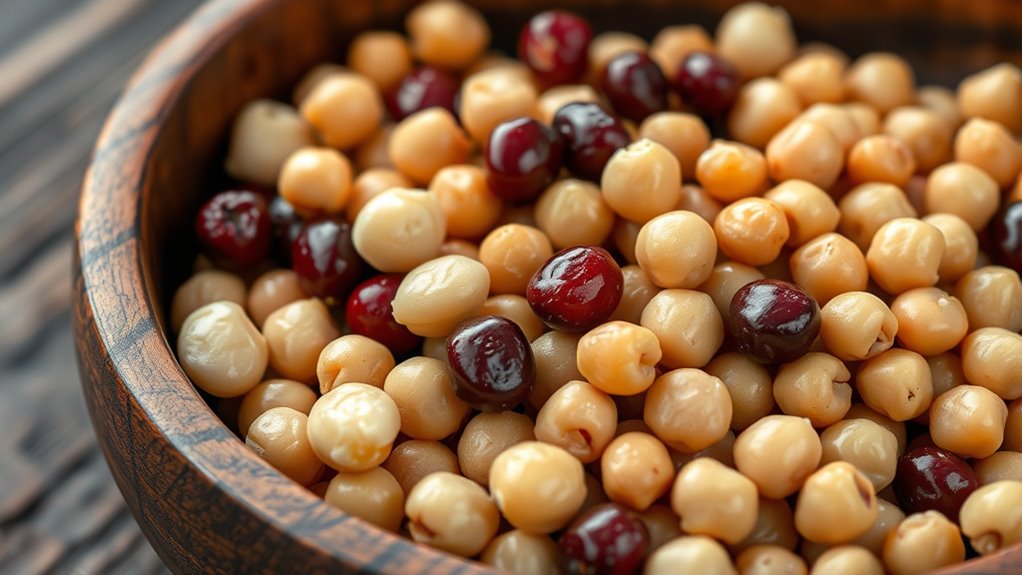Traditional Italian beans like cannellini, borlotti, and fagioli are packed with nutrients that support your health. They provide high-quality plant-based protein, dietary fiber, vitamins, and minerals like iron and magnesium. These beans help improve digestion and maintain energy levels. Proper preparation preserves their nutrient richness and enhances flavor. To discover more about their health benefits and how to incorporate them into your meals, keep exploring their nutritional secrets.
Key Takeaways
- Italian beans like cannellini, borlotti, and fagioli are rich sources of plant-based protein and dietary fiber.
- They provide essential nutrients such as iron, magnesium, potassium, and folate.
- Proper cooking methods preserve nutrient content and improve digestibility.
- Beans contain complex carbohydrates that support sustained energy release.
- Incorporating Italian beans into diets promotes balanced nutrition and cardiovascular health.

Traditional Italian beans, such as cannellini, borlotti, and fagioli, are not only staples of Italian cuisine but also packed with essential nutrients. When you prepare these beans, the cooking methods you choose can profoundly influence their nutrient retention and flavor. Boiling is the most common technique, often used to make hearty soups, stews, or salads. Slow cooking helps break down complex carbohydrates, making the beans easier to digest and revealing their full nutritional potential. Some recipes call for soaking beans overnight, which reduces cooking time and improves digestibility. Roasting or baking beans is less typical but can add a smoky flavor to dishes like bean salads or appetizers. Regardless of the method, proper preparation guarantees you maximize their health benefits while maintaining their characteristic textures and flavors. Additionally, understanding the nutritional value of these beans can help you incorporate them more effectively into a balanced diet.
Culturally, these beans hold deep significance in Italian history and traditions. They’re more than just ingredients; they symbolize regional identities and culinary heritage. For centuries, Italian families have relied on beans as a primary protein source, especially in rural areas where meat was scarce or expensive. Dishes like Tuscan fagioli all’uccelletto or Neapolitan borlotti bean stews showcase how integral these beans are to regional cuisine. They’re often associated with communal meals, family gatherings, and seasonal festivities, reinforcing their cultural importance. Preparing and sharing these dishes helps preserve cultural identity and pass down culinary traditions from generation to generation. The beans’ versatility allows them to be featured in simple, rustic recipes or sophisticated, slow-cooked masterpieces, reflecting Italy’s rich regional diversity.
Frequently Asked Questions
How Do Italian Beans Compare to Other Regional Bean Varieties Nutritionally?
When you compare Italian beans to other regional varieties, you’ll notice some nutritional variations. Italian beans often have similar protein and fiber levels but may differ in mineral content like iron and magnesium. These differences come from regional soil and growing conditions. So, your choice might influence your nutrient intake slightly, but overall, beans across regions provide great health benefits, making them a versatile, nutritious addition to your diet.
Are There Specific Health Benefits Associated With Traditional Italian Beans?
You’ll be pleased to know that traditional Italian beans offer notable health benefits. They contain powerful antioxidant properties that help fight free radicals, reducing your risk of chronic diseases. Additionally, their high fiber and protein content support heart health by lowering cholesterol levels. Including these beans in your diet can boost your overall well-being, making them a delicious, nutritious choice for maintaining a healthy lifestyle.
Do Cooking Methods Affect the Nutritional Content of Italian Beans?
Cooking techniques directly impact nutrient preservation in Italian beans. When you boil or overcook them, you risk losing water-soluble vitamins and minerals. Steaming or using gentle methods helps retain more nutrients, ensuring you get the maximum health benefits. By choosing the right cooking methods, you can enjoy flavorful beans while preserving their nutritional content, making your meal both delicious and nutritious.
What Is the Recommended Daily Intake of Italian Beans for Optimal Health?
You should aim for about 1 to 1.5 cups of cooked beans daily, which counts as your recommended servings for ideal health. This daily portion provides essential fiber, protein, and nutrients that support digestion and heart health. Incorporate Italian beans into your meals regularly, such as in salads or stews, to enjoy their benefits. Remember, balancing your diet with a variety of foods is key to maintaining good health.
Are Italian Beans Suitable for Special Diets Like Vegan or Gluten-Free?
You’ll be pleased to know that Italian beans are suitable for special diets like vegan and gluten-free ones. They’re naturally vegan-compatible, providing plant-based protein, and are gluten-free, making them safe for those with gluten sensitivities or celiac disease. Including Italian beans in your meals can support your dietary needs without sacrificing flavor or nutrition, so you can enjoy their benefits while sticking to your health goals.
Conclusion
Think of traditional Italian beans as a treasure chest, bursting with nourishing gems. Each bite release essential nutrients that fuel your body like a loyal knight defending your health. Embrace these beans as your culinary compass, guiding you through a flavorful journey toward wellness. By savoring their rich goodness, you’re not just eating—you’re nurturing your own legendary story of vitality, one delicious spoonful at a time.









